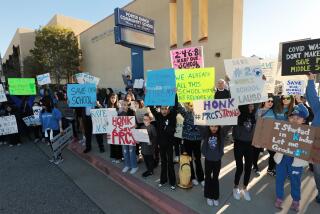Editorial: Getting serious about student absenteeism at L.A. Unified
“A mind is a terrible thing to waste,” went the memorable motto of the United Negro College Fund. Wise words. In the case of high rates of school absenteeism, there’s a double waste: The students who miss a lot of school are, no surprise, more likely to fall behind academically and stay behind. In addition, because the state allocates money to schools based on their average daily attendance, high absentee rates mean reduced funding that might otherwise be used on more resources to help young minds learn.
Last year, about 80,000 Los Angeles students missed more than 15 or more days of school, at an enormous financial and academic cost to the L.A. Unified School District. Yet the district has made little progress in curbing those absences.
It’s not as though district officials are unaware of the problem. They have set a goal of bringing more students to class regularly and have started 27 separate programs at various schools, at a cost of about $40 million per year, to reduce absenteeism. But according to a new report, released in early December by the Los Angeles Unified School District Advisory Task Force led by philanthropist and former Los Angeles Times publisher Austin Beutner, district officials have never measured the effectiveness of most of those programs. (In one case where the outcomes were tested, a relatively low-cost effort was found to have worked better than a more expensive one.)
L.A. Unified has failed to distinguish between goals and true strategic planning.
Board member Richard Vladovic agreed with the advisory group on that score. “L.A. has the greatest plans in the world and probably the worst follow-through,” he said when the report came out.
No wonder the gap between the district’s goals and reality is so large. In 2015-16, 14.3% of L.A. students — one of every seven enrolled — were chronically absent from district-run schools, the report says. The goal was to bring that down to 11% for the following academic year, which would have brought $20 million more in state funding to local schools. Instead, chronic absenteeism stuck at the previous year’s figure.
If every L.A. student came to school just one more day per year, the school district would be $30 million richer. That’s not a transformative cash infusion in a district with a budget of more than $7 billion, of course, but it’s nothing to sneeze at, either.
Adding students who miss eight to 14 days of school to the chronically absent total reveals that close to a third of the district’s students are missing school too often. The most commonly missed days were Mondays and Fridays, which parents might view as harmless extensions of the weekend. Rainy days came in second.
Recouping dollars is actually the secondary benefit of increased attendance. The report points to a study showing that attendance in eighth grade is a bigger predictor of academic success the following year than scores on the annual standardized tests. In fact, it’s eight times more likely than test scores to predict performance in that first, pivotal year of high school.
Down the line, increased attendance also should lower district costs. Better-prepared students are less likely to need remedial help in future grades. They have a better chance of graduating within four years, without needing credit-recovery courses or other interventions.
It’s time to start anew, and the odds for a smarter approach look good. District officials have been working in tandem with the outside advisory panel, and L.A. Unified might launch a pilot program as early as January in schools with the worst attendance records. It’s an evidence-based approach, modeled on successful attendance programs at other school districts, and it includes public awareness campaigns, direct mail and phone calls to the parents of frequently-absent students and other strategies. The first phase will be kept small, with a $250,000 price tag that will be split between the district and the advisory group.
Most important are the plans to measure effectiveness, abandon efforts that don’t work and expand those that do. Vladovic is right: On this and many fronts, L.A. Unified has failed to distinguish between goals and true strategic planning. This could be the moment to turn that habit around.
Follow the Opinion section on Twitter @latimesopinion and Facebook.
More to Read
A cure for the common opinion
Get thought-provoking perspectives with our weekly newsletter.
You may occasionally receive promotional content from the Los Angeles Times.






